Congestion management: Unveiling the strategies
Congestion management, the orchestration of interventions by system operators, regulators, and lawmakers takes a central role in rectifying and preventing grid imbalances. It covers a spectrum of approaches that influence power flows in accordance with operational security limits. To manage this energy challenge, these strategies span different time scales, from immediate operational adjustments to long-term investment decisions.
These strategies are categorized into four distinct groups:
Operational Time Scales: Swift adaptations within the operational horizon, including grid adjustments and switching operations, mitigate immediate congestion threats.
Grid-Related Options: Interventions targeting the grid itself, such as smart switching operations, play a pivotal role in rerouting power flows and averting congestion.
Generation and Load Dynamics: Shifting the geographic distribution of power generation and consumption contributes to alleviating congestion.
Investment Time Scales: Investments in grid expansion and the redirection of generation and load capacities enhance the grid's overall resilience and capacity.
The domino effect of unresolved congestion
The implications of unaddressed congestion are far-reaching and severe. The ripple effect of incidents triggered by congested elements or automatic protection devices can cascade into grid disconnections and further voltage, current, and frequency disturbances. The nightmarish scenario of a "rolling blackout" becomes a possibility, disrupting electricity supply to homes, businesses, and critical infrastructure. Restoring the grid after such a blackout can extend over hours or even days, underscoring the urgency of effective congestion management.
Unresolved congestion isn't just a theoretical concept; it has real-world implications that manifest differently across various regions. Two pertinent examples, the Netherlands and Limburg in Flanders, Belgium, offer insight into the severity and consequences of grid congestion.
In the Netherlands, a rapidly growing demand for electricity, coupled with an increasing reliance on renewable energy sources, has amplified the risk of grid congestion. As wind farms and solar installations sprout across the Dutch landscape, their intermittent power generation patterns can strain the existing grid infrastructure. This has caused a freeze on new connections by companies to the electrical grid.
In Flanders, the issue of congestion has so far been a more local problem restricted to certain zones in Limburg. In these zones, there have been instances of solar inverters deactivating themselves during periods of high solar energy production because the local electrical grid was too congested. This causes prosumers to miss out on the monetary compensation they would receive for injecting electricity into the grid.
The Fluvius approach: Taming congestion in Flanders
Fluvius takes a multipronged approach to congestion management in Flanders, blending innovative strategies to ensure reliable electricity distribution:
Load Balancing: Balancing demand across regions curtails localized congestion risks by optimizing electricity distribution.
Grid Reinforcement: Strengthening grid infrastructure boosts capacity, minimizing congestion vulnerabilities.
Flexibility Services: Encouraging consumer participation in load flexibility helps shift consumption patterns away from peak hours, mitigating congestion.
Demand Response Programs: Empowering consumers to reduce electricity usage during peak periods contributes to congestion alleviation.
Distributed Energy Resources (DER) Management: Collaboration with DER owners fine-tunes their operation to enhance grid stability and congestion management.
Grid Monitoring and Control: Advanced monitoring technology and real-time control safeguard against congestion by enabling swift interventions.
Fluvius' holistic approach underscores the synergy between technology, consumer engagement, and grid optimization, offering a blueprint for effectively managing congestion.
Empowering grid resilience
As energy consumption continues its upward trajectory through electrification of mobility and heating, effective congestion management emerges as the backbone in sustaining a reliable and efficient electricity supply. Innovative tactics will be necessary to guide the energy industry toward a harmonious equilibrium between supply and demand. Through vigilant monitoring, adaptive strategies, and collaborative engagement, the electric grid can continue to power the world without succumbing to the strains of congestion.








